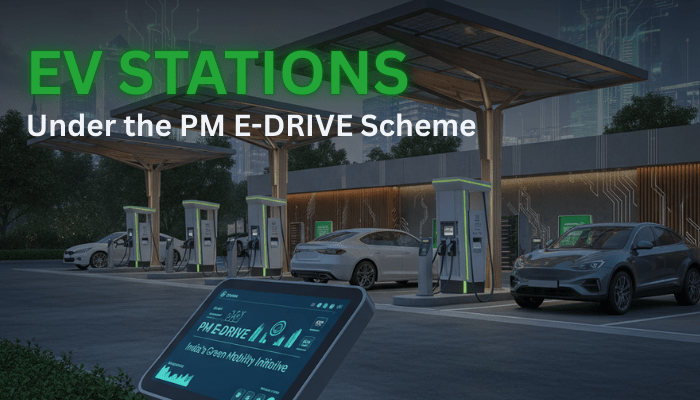India is rapidly moving towards electric mobility, and one of the key steps is building a strong EV stations infrastructure. The PM E-DRIVE (Prime Minister Electric Drive Revolution in Innovative Vehicle Enhancement) Scheme aims to set up around 72,300 public EV charging stations across the country with a budget of Rs 2,000 crore, making EV adoption easier for everyone.
Who Can Build EV Stations?

Government departments, state or union territory authorities, private companies, and commercial establishments can set up EV stations. Priority locations include:
- Government offices, hospitals, schools, and residential complexes.
- Airports, railway stations, metro and bus stations.
- PSU fuel outlets, toll plazas, and highway way-side amenities.
- Shopping malls, commercial markets, and high-traffic city areas.
The scheme focuses on cities with over one million people, smart cities, state capitals, and busy highways.
Subsidy Benefits
- The PM E-DRIVE Scheme offers attractive subsidies to reduce costs:
- 100% subsidy for EV chargers in government premises (if free for public use).
- 80% subsidy on infrastructure and 70% on chargers at public locations like airports, railway stations, and metro hubs.
- 80% subsidy on infrastructure for commercial and highway locations.
These incentives make building EV stations more affordable and encourage private investment.
Key Technical Guidelines
- Chargers must meet safety and performance standards set by the Ministry of Power.
- Support for different vehicle types, from two-wheelers to trucks.
- Charger capacities up to 12 kW for light EVs.
- Standardised connectors as per IS norms, ensuring compatibility and safety.
Following these standards is essential to qualify for subsidies.
Steps to Build EV Stations
1. Proposal Submission – Nodal agencies collect proposals from eligible entities and submit them online to the Ministry of Heavy Industries.
2. Site Selection – Locations are chosen based on traffic, population, and urban/rural spread.
3. Project Implementation – Bharat Heavy Electricals Limited (BHEL) oversees deployment and quality control.
4. Subsidy Release – Funds are given in two stages: on project start and after completion.
Benefits of Building EV Stations
- Lower upfront costs with government subsidies.
- Faster EV adoption and reduced range anxiety for users.
- Environmental benefits through cleaner transportation.
- Job creation in EV infrastructure and maintenance.
Conclusion
The PM E-DRIVE Scheme makes setting up EV stations easy, affordable, and efficient. By following the subsidy framework, technical standards, and project guidelines, both public and private players can contribute to a nationwide EV charging network.
For detailed guidelines, visit the official PM E-DRIVE portal.
Stay Ahead with My Car Wisdom, Get the Latest Car Reviews, Tips, and Buying Guides Today
Raja Yadav, the content writer at My Car Wisdom, brings a unique voice and style to our blog. With a knack for storytelling and a keen eye for detail, Raja ensures that every piece of content is informative, engaging, and easy to understand. His focus is on delivering high-quality articles that cater to both novice car owners and seasoned automotive enthusiasts.




